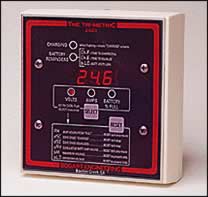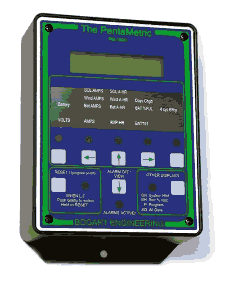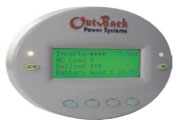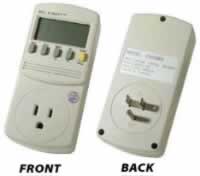& Control
You'll understand what is happening with your system and be happier with
a decent meter. Take the guess work out of how much energy is left in
your batteries, and know when to startup your backup generator. You don't
ever have to be in the dark!
A decent meter will quickly pay for itself in extended battery life, reduced
service calls, and greater understanding of your power system.
Hand held Multimeter: They are cheap, readily available, and better than nothing. For system monitoring they only offer a basic voltage reading of batteries, and have to be hooked up for each reading (not convenient). Also, very handy for testing separate batteries, modules, fuses, checking circuits and more!
Charge Controller built in Meters: We use these on our small systems. They show the battery voltage and the amount of current coming in from the solar modules, but they don't show the battery state of charge, or how much power you are using.
 Trimetric:
We insist on the Trimetric on our medium size and larger of grid
systems. It saves the installer and customer valuable drive and troubleshooting
time. We can usually talk the customer through some simple checks to see
if something is actually malfunctioning. The Trimetric shows battery voltage,
current into or out of the batteries, and most
importantly: The Trimetric shows the battery state of charge as a simple
percentage like a gas gauge. The Trimetric's onboard computer actually
keeps track of how much energy goes into and out of the batteries over
time. It also figures in efficiency and then gives you an easy to read
but accurate number of how full the batteries really are. The Trimetric
has several other features such as how many days since the batteries were
fully charged, and the highest and lowest voltage the system has hit over
time, accumulated amp hours, and more.
Trimetric:
We insist on the Trimetric on our medium size and larger of grid
systems. It saves the installer and customer valuable drive and troubleshooting
time. We can usually talk the customer through some simple checks to see
if something is actually malfunctioning. The Trimetric shows battery voltage,
current into or out of the batteries, and most
importantly: The Trimetric shows the battery state of charge as a simple
percentage like a gas gauge. The Trimetric's onboard computer actually
keeps track of how much energy goes into and out of the batteries over
time. It also figures in efficiency and then gives you an easy to read
but accurate number of how full the batteries really are. The Trimetric
has several other features such as how many days since the batteries were
fully charged, and the highest and lowest voltage the system has hit over
time, accumulated amp hours, and more.
Reading Battery % full on the Trimetric
 PentaMetric:
This is the Trimetric's new big brother. It does everything the Trimetric
does plus it can measure current on 3 different circuits at the same time,
so it could monitor how much energy your solar panels were producing,
how much energy your wind turbine was making, as well as how much you
were using. It can be programmed to read in watts or amps, and can have
as many as 50 different read outs. It even logs temperature. Further,
it can display and store all this info on a windows based computer, so
you could compare wind output from different months for example. Spread
sheets are available for analyzing the logged data.
PentaMetric:
This is the Trimetric's new big brother. It does everything the Trimetric
does plus it can measure current on 3 different circuits at the same time,
so it could monitor how much energy your solar panels were producing,
how much energy your wind turbine was making, as well as how much you
were using. It can be programmed to read in watts or amps, and can have
as many as 50 different read outs. It even logs temperature. Further,
it can display and store all this info on a windows based computer, so
you could compare wind output from different months for example. Spread
sheets are available for analyzing the logged data.
 E-Meter:
Similar functions to the Trimetric, but not as user friendly. We use these
in electric vehicles because of their small size and ability to work in
high voltage systems ( over 100 Vdc with a special adapter).
E-Meter:
Similar functions to the Trimetric, but not as user friendly. We use these
in electric vehicles because of their small size and ability to work in
high voltage systems ( over 100 Vdc with a special adapter).
 MATE:
Outback's meter and inverter control interface. It's not the best overall
meter, but necessary, if you want to reprogram an Outback inverter. The
Mate can combine the actions of the inverter with Outback's MX-60 charge
controller. The mate can connect to a PC by using Right Hand Engineering
Software to monitor your system, and log data to compare daily and monthly
production. The data available is more useful for grid tie monitoring,
and less for off grid systems.
MATE:
Outback's meter and inverter control interface. It's not the best overall
meter, but necessary, if you want to reprogram an Outback inverter. The
Mate can combine the actions of the inverter with Outback's MX-60 charge
controller. The mate can connect to a PC by using Right Hand Engineering
Software to monitor your system, and log data to compare daily and monthly
production. The data available is more useful for grid tie monitoring,
and less for off grid systems.
Link to Catalog for Current Meter Listings
 |
|
Kill-A-Watt meter similar to
Brand meter |
Measuring Power and Energy with the Brand Power Meter
by Windy Dankoff
Brand Electronics Digital Power Meters take the guesswork out of load analysis. They measure the power and energy consumption of any AC appliance, including difficult-to-meter loads such as pumps, refrigerators and freezers. The results are displayed on an easy to read 16-character LCD. The meter measures power in watts, energy in kilowatt-hours, and elapsed times in hours. You can also enter energy cost per kilowatt-hour, and it will calculate running cost.
The Brand Digital Power Meter has a heavy grounded cord and plug which you insert into any 115VAC outlet. Plug any load into the back of the meter and analysis begins automatically. Anyone can do this, as easily as plugging in an extension cord.
NOTE: For a 230V load like a water pump, the meter must be adapted for
hard wiring by a qualified electrician. The model 4-3700 will handle a
pump as large as 2 HP.
A microprocessor accurately measures voltage and current four thousand
times per second, to ensure that true power is accurately measured. The
readings are accurate regardless of power factor, and wave form distortions
(especially from small generators and non-sine-wave inverters). If the
meter loses power, a nonvolatile memory retains the accumulated data.
This instrument is the first consumer-affordable real power & energy
monitor, and is very easy to use.
Brand Power Meter 4-1850 (115VAC, 1850 watts at 1 watt resolution)
Brand Power Meter 4-3700 (115/230VAC, 3700 watts at 2 watt resolution)
Prices: Around $150. Kill-A-Watt meter is $50.00.
Some of you have seen meters at supply stores, at a lower price. These
have been found to be very inaccurate for reactive loads (most appliances,
motors, fluorescent lights). They do not register small loads less than
about 8 watts, such as a TV on standby or a small transformer. They do
not measure the entire waveform, so readings are distorted by low-peak
waveforms from small generators and from modified sine wave inverters.
The Brand Digital Power Meter is accurate under all conditions, at a very reasonable price. It belongs in every solar-electrician's toolbox and every solar dealer's merchandise shelf.
Measuring Voltage of Modified Sine Wave Inverters
by Windy Dankoff
difference between mod sine & pure sine waves
If an an inverter is not a true sine wave type (a so-called "modified sine wave" inverter), a simple voltmeter or multimeter will not read accurately. Typically it will show around 95-105V. However, the normal amount of power WILL be transferred to the load. This DOES NOT indicate a problem, but we frequently hear from customers and electricians who notice this discrepancy.
In order to measure a non-sine wave or a distorted waveform, a more expensive "true RMS" meter is required. (RMS is root-mean-square, a sort of exponential averaging.) Prices of RMS multitesters begin at around $100 in USA. If you don't have one and you want to confirm proper inverter output, simply connect a lamp with an incandescent light bulb. If it looks like its normal bright white, running on any modern inverter, you can safely assume that the RMS voltage is in its normal range.
Tools of the Trade: The DC\AC Clamp-On Ammeter\Multitester
by Windy Dankoff
The electrical multitester is often called the "right hand" of the electrical technician, but it is limited in its ability to measure current. The clamp-on ammeter fulfills that function. With it, you can measure current through a wire without disconnecting it. And, you can measure high current flow with a small instrument. The trouble is, until recently, it was an AC-only device. In recent years, DC/AC clamp-on meters became available at reasonable prices and they include standard multitester functions. They are very valuable for troubleshooting renewable energy systems.
The better clamp-on meters include "peak hold" which records highest readings, including motor starting surges. If you work with inverters and AC generators, be sure to get one that features RMS (root mean square) measurement. It will compensate for non-sine, clipped and distorted waveforms (especially the so-called "modified sine wave") in order to give a true reading of voltage and current. You can purchase a DC/AC clamp-on multitester for $140 to $300 from electrical and electronic suppliers. Manufacturers include Fluke, Amprobe, B&K Precision and Triplett.
When you go troubleshooting, take two multitesters. You will want to make simultaneous observations of voltage and current, or two different voltages. Get some electronic test clip wires so that you can take readings without hand-holding the probes. Read your meters' instruction manuals to learn useful and safe measuring techniques.
Link to Catalog for Current Listings.